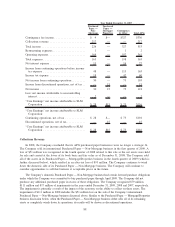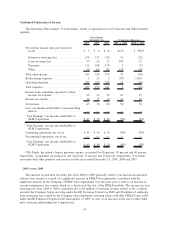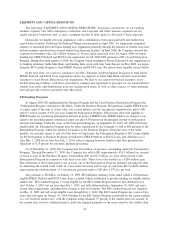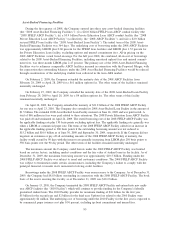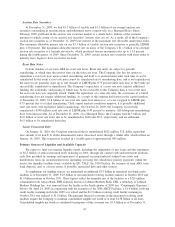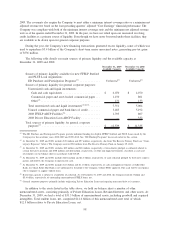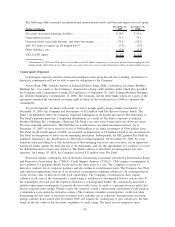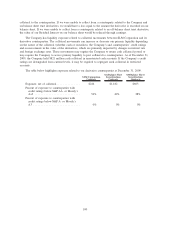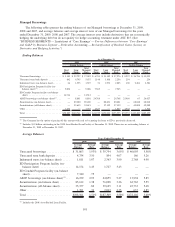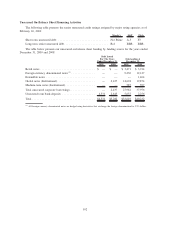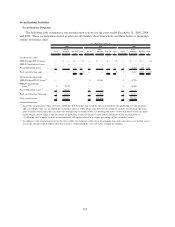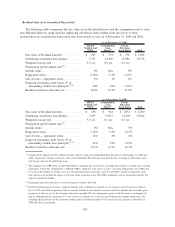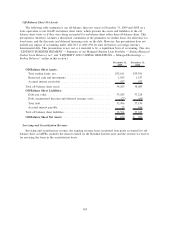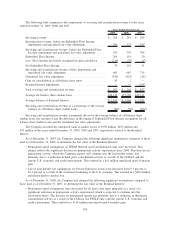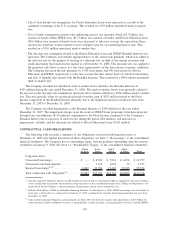Sallie Mae 2009 Annual Report Download - page 98
Download and view the complete annual report
Please find page 98 of the 2009 Sallie Mae annual report below. You can navigate through the pages in the report by either clicking on the pages listed below, or by using the keyword search tool below to find specific information within the annual report.Auction Rate Securities
At December 31, 2009, we had $3.3 billion of taxable and $1.1 billion of tax-exempt auction rate
securities outstanding in securitizations and indentured trusts, respectively, on a Managed Basis. Since
February 2008, problems in the auction rate securities market as a whole led to failures of the auctions
pursuant to which certain of our auction rate securities’ interest rates are set. As a result, all of the Company’s
auction rate securities as of December 31, 2009 bore interest at the maximum rate allowable under their terms.
The maximum allowable interest rate on our $3.3 billion of taxable auction rate securities is generally LIBOR
plus 1.50 percent. The maximum allowable interest rate on many of the Company’s $1.1 billion of tax-exempt
auction rate securities is a formula driven rate, which produced various maximum rates up to 1.14 percent
during the fourth quarter of 2009. Since December 31, 2009, certain auction rate securities with short terms to
maturity have begun to have successful auctions.
Reset Rate Notes
Certain tranches of our term ABS are reset rate notes. Reset rate notes are subject to periodic
remarketing, at which time the interest rates on the notes are reset. The Company also has the option to
repurchase a reset rate note upon a failed remarketing and hold it as an investment until such time it can be
remarketed. In the event a reset rate note cannot be remarketed on its remarketing date, and is not repurchased,
the interest rate generally steps up to and remains at LIBOR plus 0.75 percent until such time as the bonds are
successfully remarketed or repurchased. The Company’s repurchase of a reset rate note requires additional
funding, the availability and pricing of which may be less favorable to the Company than it was at the time
the reset rate note was originally issued. Unlike the repurchase of a reset rate note, the occurrence of a failed
remarketing does not require additional funding. As a result of the ongoing dislocation in the capital markets,
at December 31, 2009, $1.8 billion of our reset rate notes bore interest at, or were swapped to LIBOR plus
0.75 percent due to a failed remarketing. Until capital markets conditions improve, it is possible additional
reset rate notes will experience failed remarketings. On October 26, 2009, the Company successfully
remarketed a $590 million reset rate note at LIBOR plus 0.40 percent to maturity. All subsequent remarketings
have been unsuccessful. As of December 31, 2009, on a Managed Basis, the Company had $4.3 billion and
$2.0 billion of reset rate notes due to be remarketed in 2010 and 2011, respectively, and an additional
$6.5 billion to be remarketed thereafter.
Senior Unsecured Debt
On January 11, 2010, the Company announced that it repurchased $812 million U.S. dollar equivalent
face amount of its non-U.S. dollar denominated senior unsecured notes through a tender offer which settled on
January 14, 2010. This transaction resulted in a taxable gain of approximately $45 million.
Primary Sources of Liquidity and Available Capacity
We expect to fund our ongoing liquidity needs, including the origination of new loans and the repayment
of $5.2 billion of senior unsecured notes maturing in 2010, through our current cash and investment portfolio,
cash flow provided by earnings and repayment of principal on unencumbered student loan assets and
distributions from our securitization trusts (including servicing fees which have priority payments within the
trusts), the liquidity facilities made available by ED, TALF, the 2010 Facility, the issuance of term ABS, term
bank deposits, and, to a lesser extent, if possible, unsecured debt and other sources.
To supplement our funding sources, we maintained an additional $3.5 billion in unsecured revolving credit
facilities as of December 31, 2009; $1.9 billion of our unsecured revolving facilities matures in October 2010 and
$1.6 billion matures in October 2011. These figures reflect the amended size of the facilities as a $215 million
commitment from Aurora Bank, FSB, formerly known as Lehman Brothers Bank, FSB, a subsidiary of Lehman
Brothers Holdings Inc., was removed from the facility in the fourth quarter of 2009 (see “Counterparty Exposure,”
below). On April 24, 2009, in conjunction with the extension of the 2008 ABCP Facilities, a $1.4 billion revolving
credit facility maturing in October 2009 was retired and the $1.9 billion revolving credit facility maturing in
October 2011 was reduced to $1.6 billion. The principal financial covenants in the unsecured revolving credit
facilities require the Company to maintain consolidated tangible net worth of at least $1.38 billion at all times.
Consolidated tangible net worth as calculated for purposes of this covenant was $3.5 billion as of December 31,
97



